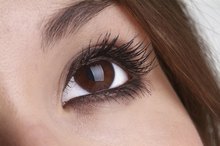How to Strengthen Hair Follicles
Hair follicles are small sacs lined with skin cells 1. Oil glands emit sebum into these sacs, which serves to protect and lubricate hair. Cells enter the sac and get packed together and pushed out resulting in hair. The hair shaft (the part of hair that you see) is made up of keratin, a form of dead protein. To strengthen hair follicles, you must adopt a healthy diet because hair is derived from your cells and its health is dependent on your health--healthy hair is strong hair 1.
Eat foods containing iron, such as dark green vegetables, beans and legumes, lean red meat or take an iron supplement. Iron carries oxygen to the hair follicles 1. A lack of oxygen can weaken the follicle.
How to Increase Keratin
Learn More
Make a place in your diet for foods containing zinc--most often found in seafood and meat. Zinc strengthens hair follicles because it binds proteins building a strong strand of hair 1. It also helps support the oil glands which protect hair. Aim for about 11 mg daily because too much zinc can interfere with the absorption of other minerals that are essential for hair health.
Eat a diet that is high in vitamins A, B, C and E. This can be achieved by eating a wide variety of fruits and vegetables and healthy fats (try avocados or olive oil). To help you choose a variety of fruits and vegetables, pick different colors. Fruits and vegetables also help hydrate the body.
How to Make Hair Grow Thicker and Faster
Learn More
Consume high protein foods such as eggs, turkey, chicken and low-fat dairy. Hair is derived from protein so having enough protein in your diet will make it stronger and healthier.
Drink at least eight cups of water daily to help hair growth and strength. Water helps the body perform all functions, including growing hair. When your body is properly hydrated your hair will be softer and supple, as opposed to dry and brittle.
Related Articles
References
- Medicine Net: Hair Follicles
- Phillips TG, Slomiany WP, Allison R. Hair Loss: Common Causes and Treatment. Am Fam Physician. 2017;96(6):371-378.
- Watras MM, Patel JP, Arya R. Traditional anticoagulants and hair loss: a role for direct oral anticoagulants? A review of the literature. Drugs Real World Outcomes. 2016;3(1):1-6. doi:10.1007/s40801-015-0056-z
- Urysiak-czubatka I, Kmieć ML, Broniarczyk-dyła G. Assessment of the usefulness of dihydrotestosterone in the diagnostics of patients with androgenetic alopecia. Postepy Dermatol Alergol. 2014;31(4):207-15. doi:10.5114/pdia.2014.40925
- Vincent M, Yogiraj K. A descriptive study of alopecia patterns and their relation to thyroid dysfunction. Int J Trichology. 2013;5(1):57-60. doi:10.4103/0974-7753.114701
- Peters EMJ, Müller Y, Snaga W, et al. Hair and stress: A pilot study of hair and cytokine balance alteration in healthy young women under major exam stress. PLoS ONE. 2017;12(4):e0175904. doi:10.1371/journal.pone.0175904
- Pratt CH, King LE, Messenger AG, Christiano AM, Sundberg JP. Alopecia areata. Nat Rev Dis Primers. 2017;3:17011. doi:10.1038/nrdp.2017.11
- American Academy of Dermatology. Alopecia Areata: Overview.
Writer Bio
Maggie Lynn has been writing about education, parenting and health topics since 2005, in addition to being an educator. She holds a Master of Science in child and family studies.









